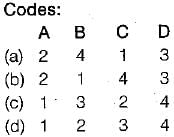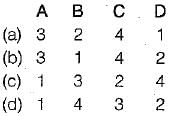Test: Sound Broadcast Transmitting & Superheterodyne Receivers - Electronics and Communication Engineering (ECE) MCQ
10 Questions MCQ Test GATE ECE (Electronics) Mock Test Series 2025 - Test: Sound Broadcast Transmitting & Superheterodyne Receivers
In order to minimize the noise power a filter is introduced
The last and the first stages in a superheterodyne receiver are respectively
| 1 Crore+ students have signed up on EduRev. Have you? Download the App |
The output signal to noise ratio depends upon .
Match List-I (Superheterodyne receiver characteristics) with List-II (Features/Cause) and select the correct answer using the codes given below the lists:
List-I
A. Double spotting
B. Sensitivity
C. Fidelity
D. Selectivity
List-II
1. Ability to reproduce all the modulating frequencies equally.
2. Occurs due to inadequate image-frequency rejection.
3. Ability to rejected unwanted signal.
4. Ability to amplify weak signals.

Assertion (A): The figure of merit of a receiver is always more than unity.
Reason (R): The figure of merit must be as high as possible because higher value of figure of merit indicates better noise performance of the receiver.
The sensitivity of a superheterodyne receiver does not depend on
Consider the following statements:
1. The figure of merit of DSB-SC and SSB receivers with coherent detection is 1.
2. The figure of merit of an AM receiver with envelope detection is more than 1.
3. If the average modulated signal power and the average noise power in the message bandwidth is same as that of DSB-SCreceiver then the output SNR and figure of merit of SSB coherent receiver is same as that of the DSB SC receiver.
4. A square-law demodulator operates above threshold on a weaker signal than with an envelope demodulator.
Which of the above statements are correct?
Match List-I (Classification of radio receivers) with List-II (Applications) and select the correct answer using the codes given below the lists:
List-I
A. A.M. Broadcast receivers
B. F.M. Broadcast receivers
C. Communication receivers
D. Radar receivers
List-II
1. Operate in VHF or UHF bands.
2. Used to receive radio detection and ranging
3. Operate on long, medium and short wave bands.
4. Used for reception of telegraph and short wave telephone signals.
Codes:

Which of the following is not an uncoded system?
The main function of a radio receiver is to
1. amplify the modulating frequency signal.
2. amplify the selected R.F. (radio frequency) signal.
3. select the desired signal and reject the unwanted signals.
4. intercept the incoming modulated signal by the receiving antenna.
5. detect the modulated signal to get back the original modulating or baseband signal.
Of these, the correct statements are:
|
25 docs|263 tests
|
|
25 docs|263 tests
|




















